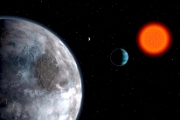Viewings: 6446

Thanks to recent work of the American astrophysicists the title of the oldest stars awarded HD 140283 that shines just 186 light years from Earth. This number is 13.9 billion years, making it shone almost the same age as our Universe. But the interesting thing is that this "old" - typical star of the second generation.
Fascinating spectacle of the starry sky! It is always well - sparkling diamond Sirius, ruby glows Antares, the abyss of the milky Way spill starry river... Which of stars is the oldest? How and when found? The answer has sounded quite recently - in January 2013! This star is named HD 140283, and her age coincides with the age of the Universe!
This discovery, which we describe in detail, has pressed the previous candidate for this Patriarchal title: the star HE 1523-0901, representing a red giant in the constellation of Libra. It belongs to the second generation of the stellar population of the Universe, and it has very low metallicity: Fe/H= -2,95.
This star has already contributed astronomer Anna Frebel (University of Texas) in the environment marginal stars in the milky Way using data of super-telescope (VLT) at the European southern Observatory. Life light lasts about 13.2 billion years old, she almost the same age of the Universe - a difference of half a billion years is not so great on the cosmic time scale. Opening dated may 10, 2007, an article published in ApJ. But now the priority of the star HE 1523-0901 ceded the oldest star subgiant HD 140283, which is located much closer to the Sun!
I must say that any star is astrophysicists your detailed "passport" - namely, the data of spectral studies. For research of the age of the stars are the same physical method as on Earth at the Dating of the ancient discoveries in paleontology or archaeology - radioisotope analysis. Radioactive isotopes with a huge half-life osmium, iridium or europium supply information about how much the sun years.
The oldest stars formed from explosive clouds supernova first generation that gave rise to all chemical elements, including radioactive, which is now Dating the age of the stars of the second generation. According to calculations, such HD 140283 is estimated from 13.2 to 13.9 billion years. And we must not confuse the caveat that the age limit, that is, the lower bound, even better than the age of the Universe - these are features of the estimates, the validity of which, however, is quite acceptable.
So, now the title of the oldest stars awarded HD 140283 that shines just 186 light years from Earth. It happened in the result of the efforts of the research team under the leadership of Howard bond (Howard Bond of the University of Pennsylvania (USA). More than a hundred years it is known to astronomers as the ancient variable star, but its exact age would be defined only in 2013.
Chemical composition HD 140283 installed exactly is hydrogen and helium, with a minimum number of metals. This suggests that the "old" - typical star of the second generation of the stellar population, which was preceded by the third generation of light, much more metallic. Scientists believe that the second generation survived only the least massive star, a representative of which is HD 140283, luminosity and distance to it were measured with a maximum for a real-time accuracy. The most accurate indication of venerable age was revealed reduction of luminosity HD 140283, in the depths of which fade in fusion processes of hydrogen in the implementation of thermonuclear reactions. When you were with high reliability calculated (as evidenced by author Howard bond) estimate the parameters of this function, the figures were formally exceeding the age of the Universe: HD 140283 there 13,9 ± of 0.7 billion years. It surpassed the aforementioned star, and now ex-champion of age HE 1523-0901.
Itself the Big Bang extends in time of 13.75 ? 0.11 billion years from the first moment to our time, is believed to cosmologists. Therefore, the minimum age of the oldest stars HD 140283 13.2 billion years differentiates them from the set forth: it not only over the age of our Galaxy, but protogalactic in which it was formed. The authors consider its current age of the Universe! It should be noted that the stars of the first generation, apparently, were huge and short-lived. They served "factories" achievements of chemical elements, including all of the heavy metals. Although identified star-Patriarch has an extremely low metallicity, but insignificant admixture of heavy elements in it there is a trace of the first generation of stars.
Monstrous firecrackers stars of the first generation not instantly born and was proanalizirovani at the dawn of the Universe - yet their life scientists estimated at several hundred million years. And according to the calculations, it turns out that the star HD 140283 age equal Universe! There is a certain mystery to be solved. How explicit the asterisk second generation was older than the stars of the first?
Perhaps the problem metallicity will be examined more carefully in the future and the explanation of the mysterious features you will surely find. Tens of millions of years, as is believed today, scientists took the first generation stars on the formation, explosive metamorphosis, cooling products, radically different from the original composition... And only then came the second stage of the birth of light. The inhomogeneity and the diversity of the composition of the huge expanding (so far!) The universe could provide a number of features in the formation of stars.
This, perhaps, scientists will find answers to the riddles of the Universe. Since the twentieth century, the development of knowledge about space associated with new, previously unknown to the objective realities. This dark matter, black holes, exotic quasi-star facilities - quasars and pulsars. And on this background even more interesting look riddles stars) is false, only seemingly so simple!
















